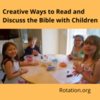This topic is sharing ideas about creatively improving the step of the Sunday School lesson where we open our Bibles and read the scripture with or to our students.
It begins with some posts originally created by Neil MacQueen, one of the Lead Writers of Rotation.org's Writing Team. You are encouraged to post your insights and ideas.
SOME CREATIVE and PLAYFUL WAYS TO READ THE BIBLE WITH KIDS
from Neil MacQueen
 Taking a creative and playful approach builds anticipation, grabs their attention, helps kids get over their fear of reading or being called upon, sets an interactive tone of participation right from the beginning of the lesson, and promotes retention of content.
Taking a creative and playful approach builds anticipation, grabs their attention, helps kids get over their fear of reading or being called upon, sets an interactive tone of participation right from the beginning of the lesson, and promotes retention of content.
Here are some types of techniques I have used in scripture reading. Some are pretty playful, and the approach can depend on what kind of passage you are studying. All can be adapted for kids of any age. Especially with older kids and youth, a playful approach loosens them up around their peers.
1. Props! A few simple props to show or pass to the next reader can do a sneaky job of creating anticipation and focusing attention. Scan the story for prop ideas. Something as simple as a costume or headwrap helps make the reading fun and content stick. I will sometimes bring in action figures to pass around and represent the characters. ("Spiderman Jesus" was probably my favorite.) The simple presence of those figures made the kids enjoy the reading and discussion so much more.
2. Assign roles! When the story warrants it, I will assign kids to 'do the lines' for various characters. We'll talk about "what voice" and some "body language" to add to the reading. Invariably we'll have to do it twice because they enjoy switching roles and getting into character.
3. Look to the Workshop's MEDIA for your inspiration!
- If I'm in the Art Workshop, we might draw the scene as we read it, or mold it with playdough. (Draw this, read, add that, read more, etc.)
- If I'm in the Game Workshop we might spin a spinner to assign reading parts.
- If I'm in the Drama Workshop we might have the kids "show us your freeze face reaction" to certain lines read in the scripture.
- If I'm in the computer workshop we'll look to see the scripture on the screen.
- If I'm in the Music workshop we might practice saying/rapping/singing the verses with a beat.
- If I'm in the "Story" Workshop I'd invite a storyteller to deliver the scripture.
- If I'm in the "Construction" workshop, we might give kids a pile of legos, assign verses and have them build the keyword in their verse before reading it and showing their keyword to the class.
4. Mr. Microphone!  I've mentioned this in several posted lessons Kids LOVE to speak into a microphone. So I will sometimes bring in my microphone and a small guitar amplifier. We pass the microphone between speakers. God's voice is always the one they have fun with. That microphone creates anticipation, fights distractions, promotes goodwill, and is quite a bit of fun. It also gives them a reason to want to "do it again" which is a great way to promote retention.
I've mentioned this in several posted lessons Kids LOVE to speak into a microphone. So I will sometimes bring in my microphone and a small guitar amplifier. We pass the microphone between speakers. God's voice is always the one they have fun with. That microphone creates anticipation, fights distractions, promotes goodwill, and is quite a bit of fun. It also gives them a reason to want to "do it again" which is a great way to promote retention.
UPDATE: Amazon now sells a kids “Karaoke” microphone that has its own built-in speaker and volume control (and voice filters). My kids love using it! It’s rechargeable and only $14. Great for narrators too.

5. Set up the Scene and Act It Out! Example: For "man let down through the roof," we made a square of our tables, sat on the tabletops, sitting on the blanket stretched across the opening in the middle of the tables we had created. The kids knew what was coming and focused like crazy. We read the second part of that story UNDERNEATH the tables. Use the story's setting to help you think about what you can do while they read with you.
6. Use a Computer! ![]() A lot of software programs have the Bible story fully presented in a fun way. You can also project the Bible text (amazing what having a glowing version on the screen or wall does for student attention). You can also use a software program like "Let's Talk" to type your verses into and have them read back by an animated character, with a computer voice. Fun!
A lot of software programs have the Bible story fully presented in a fun way. You can also project the Bible text (amazing what having a glowing version on the screen or wall does for student attention). You can also use a software program like "Let's Talk" to type your verses into and have them read back by an animated character, with a computer voice. Fun!
7. Read in Voices After doing a straight reading, assign 'characters' or verses, and then discuss "what creative voice" they could read their verse in. Creative Voices help kids REMEMBER and it is instructive to discuss which voice fits the characters or lines of scripture. Fun ones to use: The Hulk, Rapper Drake, Choir Voice, The Presidential Voice, Surfer Dude, Whisper Girl. Ask your kids. They'll know.
8. LIP SYNC & MIME LINES Invite pairs of students to prepare then come forward --one slowly reading the passage, while the other acts it out, ...mimes, lip-sync what the reader is saying. This is especially effective where there is one person, like Jesus, who is doing the talking, or where there's action to be acted.
Hope this gives you a start.
<>< Neil
If you appreciate free resources like this one, become a Supporting Member. Rotation.org is a 501(c)3 non-profit that depends on its Supporting Members.







